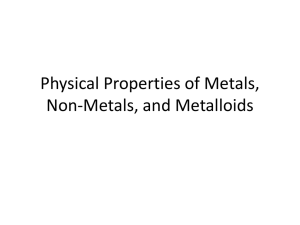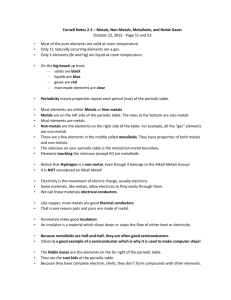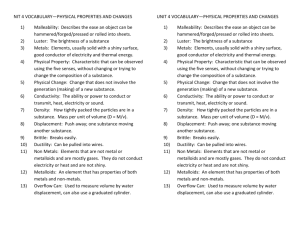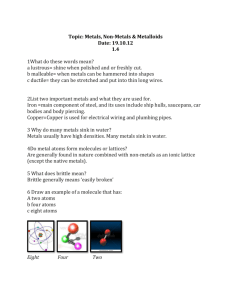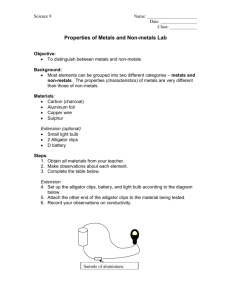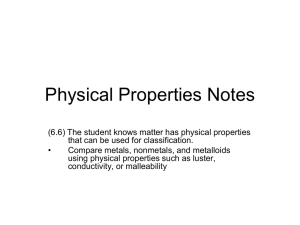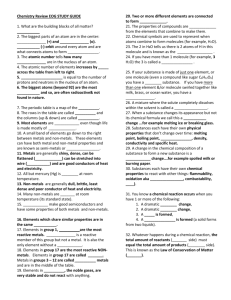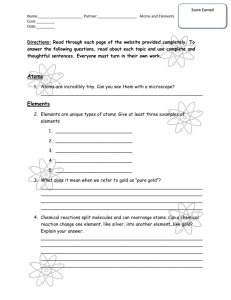Metals, Non-Metals, Metalloids Quiz
advertisement
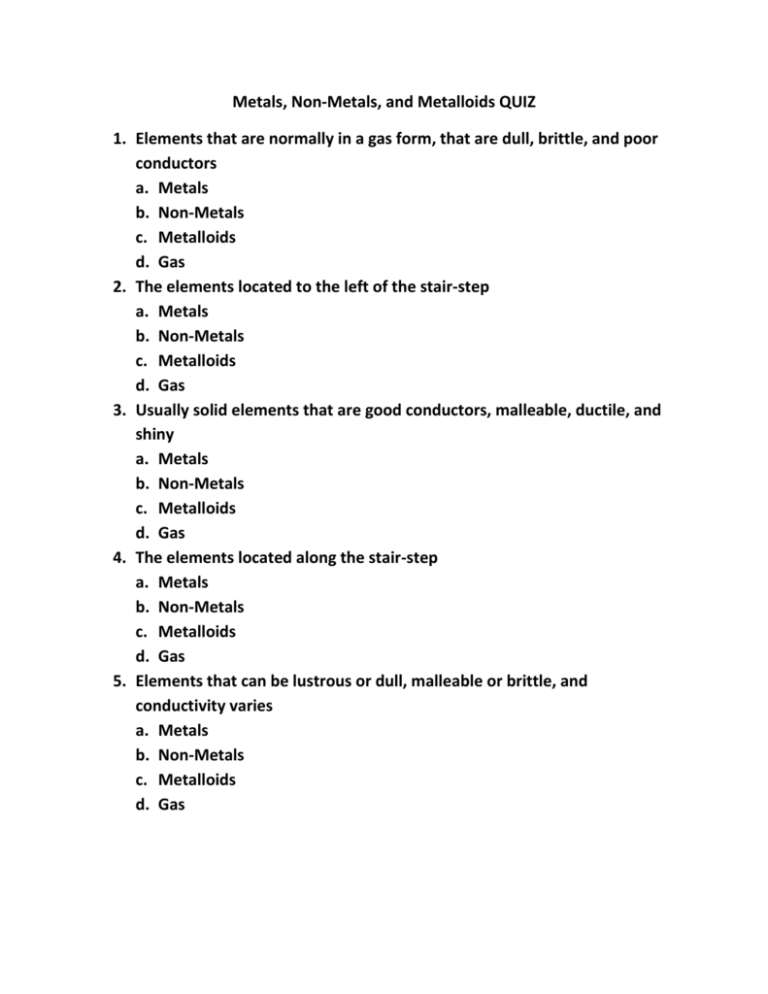
Metals, Non-Metals, and Metalloids QUIZ 1. Elements that are normally in a gas form, that are dull, brittle, and poor conductors a. Metals b. Non-Metals c. Metalloids d. Gas 2. The elements located to the left of the stair-step a. Metals b. Non-Metals c. Metalloids d. Gas 3. Usually solid elements that are good conductors, malleable, ductile, and shiny a. Metals b. Non-Metals c. Metalloids d. Gas 4. The elements located along the stair-step a. Metals b. Non-Metals c. Metalloids d. Gas 5. Elements that can be lustrous or dull, malleable or brittle, and conductivity varies a. Metals b. Non-Metals c. Metalloids d. Gas 6. A row (horizontal) on the periodic table is called a a. Period b. Family c. Group d. Row 7. Which type of element is located to the right of the stair-step? a. Metals b. Non-Metals c. Metalloids d. Gas 8. A column (vertical) on the periodic table is called a a. Period b. Family c. Group d. Row 9. Boron and Silicon are a. Metals b. Non-Metals c. Metalloids d. Gas 10.The elements that share properties of both metals and non-metals are called a. Metals b. Non-Metals c. Metalloids d. Gas 11.When a substance has a high luster, high malleability/ductility and a high conductivity, it is a a. Metal b. Non-Metal c. Metalloid d. Noble Gas 12.A metal has to have 3 physical properties to be classified as a metal a. Magnetic, poor conductor, brittle b. High luster, malleable, good conductor c. Break easily, ductile, poor conductor d. Poor conductor, high luster, magnetic 13. Metals are found where on the periodic table a. Right side of the table b. Left side of the table c. Along the stair-step d. On the bottom of the table 14.The majority of the periodic table is made up of a. Metals b. Non-Metals c. Metalloids d. Noble Gases 15.What group is on the stair-step or zig-zag line of the periodic table? a. Metals b. Non-Metals c. Metalloids d. Noble Gases 16.Silicon is a member of this group and exhibits properties of both metals and non-metals a. Metals b. Non-Metals c. Metalloids d. Noble Gases 17.These elements occur in a variety of states and colors a. Metals b. Non-Metals c. Metalloids d. Noble Gases 18.These elements have luster, are malleable, ductile, and are good conductors of electricity a. Metals b. Non-Metals c. Metalloids d. Noble Gases 19.Metals and Metalloids typically occur in which state? a. Solid b. Liquid c. Gas d. Plasma 20.These elements are nonconductors (do not conduct heat or electricity.) a. Metals b. Non-Metals c. Metalloids d. Noble Gases 21.This element is in Group 1, but it is not a metal a. Potassium b. Sodium c. Hydrogen d. Helium 22.This term is used for a metal that is able to be drawn out into a thin wire a. Malleable b. Ductile c. Luster d. Conductivity 23.This is the term used for a metal that is able to be hammered out or pressed a. Malleable b. Ductile c. Luster d. Conductivity 24.What physical properties are used to classify elements as metals, nonmetals, or metalloids? a. Color, smell, physical state b. Reactivity, streak, hardness c. Ability to burn, mass, density d. Luster, conductivity, malleability 25.The elements argon, krypton, and xenon are all non-metals. What property would these elements have in common? a. Good conductor of thermal energy b. Poor conductor of electricity c. Shiny, lustrous surface d. Soft and malleable 26.Which of the following correctly lists the 3 main groups of elements from greatest conductivity to least conductivity? a. Non-Metal->Metalloid->Metals b. Metals->Non-Metals->Metalloids c. Metalloids->Metals->Non-Metals d. Metals->Metalloids->Non-Metals 27.The word “luster” refers to which property of matter? a. The ability to conduct electrical or thermal energy b. Capable of being drawn out into thin wires c. The way a surface appears when it reflects light d. Suitable for being shaped by beating or rolling
